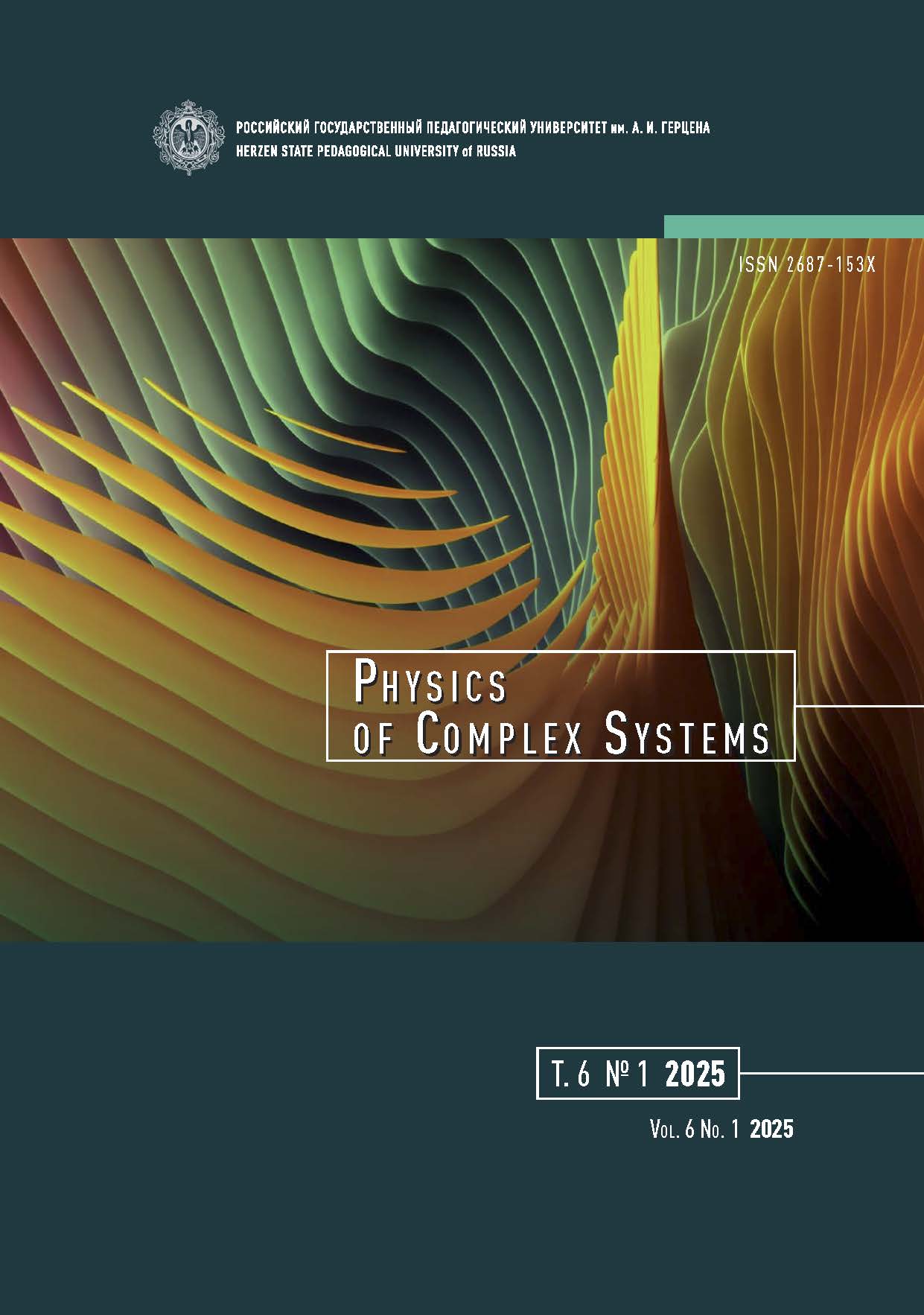Charge transport mechanism and memristive effect in a thin film based on fluorinated polyaryl ether containing 1,4-dioxo-thioxanthene-9-one in-chain blocks
DOI:
https://doi.org/10.33910/2687-153X-2025-6-1-9-16Keywords:
fluorinated polymers, charge transport, memristor, trap, photoluminescence, photoluminescence excitation spectraAbstract
A new fluorinated thermally stable polyaryl ether with electron-withdrawing thioxanthenone in-chain block (FPAE-ThS) was synthesized through the interaction of perfluorobiphenyl with 1,4-dihydroxy-9H-thioxanthene-9-one. The charge transport mechanism within the FPAE-ThS film is governed by the phonon-assisted tunneling between neighbouring traps. The thermal (1.0 eV) and optical trap (2.0 eV) ionization energies, as well as the trap concentration (N = 1.0 × 1020 cm–3), are determined. The value of half Stokes shift (1.1 eV), obtained from the photoluminescence and photoluminescence excitation spectra, is consistent with the results of charge transport simulation. Furthermore, a prototype memory device based on the FPAE-ThS film demonstrates the resistive switching behavior with a four-order difference in the resistance between its low- and high-resistance states.
References
Dunlap, D. H., Parris, P. E., Kenkre, V. M. (1996) Charge-dipole model for the universal field dependence of mobilities in molecularly doped polymers. Physical Review Letters, 77, article 542. https://doi.org/10.1103/PhysRevLett.77.542 (In English)
Frenkel, J. (1938) On pre-breakdown phenomena in insulators and electronic semi-conductors. Physical Review, 54, 647–648. https://doi.org/10.1103/PhysRev.54.647 (In English)
Ganichev, S. D., Ziemann, E., Prettl, W. et al. (2000) Distinction between the Poole-Frenkel and tunneling models of electric-field-stimulated carrier emission from deep levels in semiconductors. Physical Review B, 61, 10361–10365. https://doi.org/10.1103/PhysRevB.61.10361 (In English)
Gismatulin, A. A., Odintsov, D. S., Shundrina, I. K. et al. (2024) Charge transport mechanism and trap origin in methyl methacrylate copolymer with thioxanthenone side groups. Chemical Physics Letters, 840, article 141140. https://doi.org/10.1016/j.cplett.2024.141140 (In English)
Gritsenko, V. A., Perevalov, T. V., Voronkovskii, V. A. et al. (2018) Charge transport and the nature of traps in oxygen deficient tantalum oxide. ACS Applied Materials & Interfaces, 10, 3769−3775. https://doi.org/10.1021/acsami.7b16753 (In English)
Hirao, A., Nishizawa, H., Sugiuchi, M. (1995) Diffusion and drift of charge carriers in molecularly doped polymers. Physical Review Letters, 75, 1787–1790. https://doi.org/10.1103/PhysRevLett.75.1787 (In English)
Jiang, X., Yin, J. (2014a) Copolymeric photoinitiators containing in-chain thioxanthone and coinitiator amine for photopolymerization. Journal of Applied Polymer Science, 94, 2395–2400. https://doi.org/10.1002/app.21178 (In English)
Jiang, X., Yin, J. (2014b) Polymeric photoinitiator containing in-chain thioxanthone and coinitiator amines. Macromolecular Rapid Communications, 25, 748–752. https://doi.org/10.1002/marc.200300270 (In English)
Kronemeijer, A. J., Pecunia, V., Venkateshvaran, D. et al. (2014) Two-dimensional carrier distribution in top-gate polymer field-effect transistors: correlation between width of density of localized states and Urbach energy. Advanced Materials, 26, 728–733. https://doi.org/10.1002/adma.201303060 (In English)
Kumar, M., Pereira, L. (2020) Towards highly efficient TADF yellow-red OLEDs fabricated by solution deposition methods: Critical influence of the active layer morphology. Nanomaterials, 10 (1), article 101. https://doi.org/10.3390/nano10010101 (In English)
Loskutov, V. A., Beregovaya, I. V. (2009) Reaction of thiosalicylic acid with 1,4-quinones and cyclization of the resulting arylsulfanylbenzoic acids. Russian Journal of Organic Chemistry, 45, 1405–1409. https://doi.org/10.1134/S1070428009090152 (In English)
Nasyrov, K. A., Gritsenko, V. A. (2011) Charge transport in dielectrics via tunneling between traps. Journal of Applied Physics, 109, article 093705. https://doi.org/10.1063/1.3587452 (In English)
Nasyrov, K. A., Gritsenko, V. A. (2013) Transport mechanisms of electrons and holes in dielectric films. Physics Uspekhi, 56, 999–1012. https://doi.org/10.3367/UFNe.0183.201310h.1099 (In English)
Nazir, R., Balciunas, E., Buczynska, D. et al. (2015) Donor–acceptor type thioxanthones: Synthesis, optical properties, and two-photon induced polymerization. Macromolecules, 48, 2466–2472. https://doi.org/10.1021/acs.macromol.5b00336 (In English)
Neumann, M. G., Gehlen, M. H., Encinas, M. V. et al. (1997) Photophysics and photoreactivity of substituted thioxanthones. Journal of the Chemical Society, Faraday Transactions, 93, 1517–1521. https://doi.org/10.1039/A607264J (In English)
Novikov, S. V., Dunlap, D. H., Kenkre, V. M. et al. (1998) Essential role of correlations in governing charge transport in disordered organic materials. Physical Review Letters, 81, article 4472. https://doi.org/10.1103/PhysRevLett.81.4472 (In English)
Odintsov, D. S., Shundrina, I. K., Gismatulin, A. A. et al. (2022) Heat-resistant polyimides with electron-acceptor pendant groups of the thioxanthenone series for resistive storage devices with a low switching voltage. Journal of Structural Chemistry, 63, 1811–1819. https://doi.org/10.1134/S0022476622110117 (In English)
Odintsov, D. S., Os’kina, I. A., Irtegova, I. G. et al. (2023) Electrochemical reduction of 1H-thioxanthene-1,4,9-trione and 3-methyl-1H-thioxanthene-1,4,9-trione—representatives of a new class of heterocycles related to thioxanthenone. European Journal of Organic Chemistry, 26 (33), article e202300459. https://doi.org/10.1002/ejoc.202300459 (In English)
Schroeder, H. (2015) Poole-Frenkel-effect as dominating current mechanism in thin oxide films — an illusion?! Journal of Applied Physics, 117, article 215103. https://doi.org/10.1063/1.4921949 (In English)
Shaposhnik, P. A., Zapunidi, S. A., Shestakov, M. V. et al. (2020) Modern bio and chemical sensors and neuromorphic devices based on organic semiconductors. Russian Chemical Reviews, 89, 1483–1506. https://doi.org/10.1070/rcr4973 (In English)
Vasilieva, N. V., Irtegova, I. G., Loskutov, V. A. et al. (2012) Redox properties and radical anions of 2-substituted thioxanthen-9-ones and their 2-methyl S-oxide derivatives. Mendeleev Communications, 23 (6), 334–336. https://doi.org/10.1016/j.mencom.2013.11.010 (In English)
Wang, H., Xie, L., Peng, Q. et al. (2014) Novel thermally activated delayed fluorescence materials–thioxanthone derivatives and their applications for highly efficient OLEDs. Advanced Materials, 26, 5198–5204. https://doi.org/10.1002/adma.201401393 (In English)
Wang, Y., Zhu, Y., Xie, G. et al. (2018) Red thermally activated delayed fluorescence polymers containing 9H-thioxanthen-9-one-10,10-dioxide acceptor group as pendant or incorporated in backbone. Organic Electronics, 59, 406–413. https://doi.org/10.1016/j.orgel.2018.05.058 (In English)
Wu, Q., Xiong, Y., Liang, Q. et al. (2014) Developing thioxanthone based visible photoinitiators for radical polymerization. RSC Advances, 4, article 52324. https://doi.org/10.1039/C4RA07614A (In English)
Yilmaz, G., Tuzun, A., Yaggi, Y. (2010) Thioxanthone–carbazole as a visible light photoinitiator for free radical polymerization. Journal of Polymer Science. Part A: Polymer Chemistry, 48, 5120–5125. https://doi.org/10.1002/pola.24310 (In English)
Yuan, L., Liu, S., Chen, W. et al. (2021) Organic memory and memristors: From mechanisms, materials to devices. Advanced Electronic Materials, 7 (11), article 2100432. https://doi.org/10.1002/aelm.202100432 (In English)
Downloads
Published
Issue
Section
License
Copyright (c) 2025 Andrei A. Gismatulin, Vladimir A. Pustovarov, Danila S. Odintsov, Irina A. Os’kina, Inna K. Shundrina, Ivan A. Azarov, Leonid A. Shundrin, Vladimir A. Gritsenko

This work is licensed under a Creative Commons Attribution-NonCommercial 4.0 International License.
The work is provided under the terms of the Public Offer and of Creative Commons public license Creative Commons Attribution 4.0 International (CC BY 4.0).
This license permits an unlimited number of users to copy and redistribute the material in any medium or format, and to remix, transform, and build upon the material for any purpose, including commercial use.
This license retains copyright for the authors but allows others to freely distribute, use, and adapt the work, on the mandatory condition that appropriate credit is given. Users must provide a correct link to the original publication in our journal, cite the authors' names, and indicate if any changes were made.
Copyright remains with the authors. The CC BY 4.0 license does not transfer rights to third parties but rather grants users prior permission for use, provided the attribution condition is met. Any use of the work will be governed by the terms of this license.







